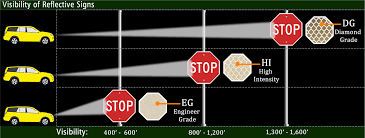But all traffic sign face must be reflective unless coloured black. For traffic signs to be compliant, they must meet the correct standard of retroreflection and regulated colour for the application.

There is plenty of choice in regard to traffic signs; size, shape, material, reflectivity and more can vary. All these aspects play an important role in keeping road users safe, whether that’s through directing traffic, warning of hazards, or protecting workers at street works. The reflectivity, in particular, ensures road users see important information during dark hours and plays a critical role in both compliance and lifesaving.
What is reflective sheeting for traffic signs?
Traffic signs are normally made from a Aluminium, which is then covered with reflective sheeting. Reflective sheeting is the material that makes road signs visible in the dark without having to rely on electricity.
Types of reflective sheeting for traffic signs
Retroreflective glass bead sheeting
Glass bead tapes use microscopic glass spheres to bend and reflect light back to the light source. Because of the imperfections and curved surfaces in glass beads, sheeting made with beads are less reflective than tapes made with prisms. Glass bead sheeting are about 30% efficient. This is a disadvantage. However, there are three advantages that glass bead sheeting has over most prismatic sheeting. First, glass bead reflective sheeting are much more affordable. This is because they are simpler to manufacture. Second, most glass bead sheeting are CAD cuttable meaning that you can cut letters, number and designs out of the tape and create reflective signs or graphics. Third, glass bead sheeting reflect light back at wider angles. In other words, glass bead sheeting are sort of like flood lamps whereas prismatic sheeting are more light spot lights.
Micro prismatic sheeting
Prismatic is more efficient and returns about 80% of the light sent to it. Therefore it is brighter than glass bead tapes. Prismatic tape reflects light via man made prisms. Since the mirrors are flat and not curved they are more efficient. The light sent from the tape is more focused and can therefore travel farther still be seen. In different countries will have different regulatory requirements for road signs.
But all traffic sign face must be reflective unless coloured black. For traffic signs to be compliant, they must meet the correct standard of retroreflection and regulated colour for the application.
There is plenty of choice in regard to traffic signs; size, shape, material, reflectivity and more can vary. All these aspects play an important role in keeping road users safe, whether that’s through directing traffic, warning of hazards, or protecting workers at street works. The reflectivity, in particular, ensures road users see important information during dark hours and plays a critical role in both compliance and lifesaving.
What is reflective sheeting for traffic signs?
Traffic signs are normally made from a Aluminium, which is then covered with reflective sheeting. Reflective sheeting is the material that makes road signs visible in the dark without having to rely on electricity.
Types of reflective sheeting for traffic signs
Retroreflective glass bead sheeting
Glass bead tapes use microscopic glass spheres to bend and reflect light back to the light source. Because of the imperfections and curved surfaces in glass beads, sheeting made with beads are less reflective than tapes made with prisms. Glass bead sheeting are about 30% efficient. This is a disadvantage. However, there are three advantages that glass bead sheeting has over most prismatic sheeting. First, glass bead reflective sheeting are much more affordable. This is because they are simpler to manufacture. Second, most glass bead sheeting are CAD cuttable meaning that you can cut letters, number and designs out of the tape and create reflective signs or graphics. Third, glass bead sheeting reflect light back at wider angles. In other words, glass bead sheeting are sort of like flood lamps whereas prismatic sheeting are more light spot lights.
Micro prismatic sheeting
Prismatic is more efficient and returns about 80% of the light sent to it. Therefore it is brighter than glass bead tapes. Prismatic tape reflects light via man made prisms. Since the mirrors are flat and not curved they are more efficient. The light sent from the tape is more focused and can therefore travel farther still be seen.
